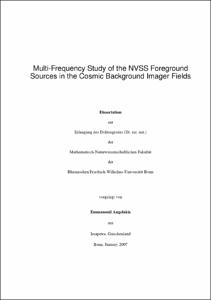Multi-Frequency Study of the NVSS Foreground Sources in the Cosmic Background Imager Fields

Multi-Frequency Study of the NVSS Foreground Sources in the Cosmic Background Imager Fields

| dc.contributor.advisor | Klein, Ulrich | |
| dc.contributor.author | Angelakis, Emmanouil | |
| dc.date.accessioned | 2020-04-10T13:44:59Z | |
| dc.date.available | 2020-04-10T13:44:59Z | |
| dc.date.issued | 2007 | |
| dc.identifier.uri | https://hdl.handle.net/20.500.11811/3060 | |
| dc.description.abstract | The point radio sources comprise one amongst the major contaminants of the Cosmic Microwave Background radiation. Consequently, they possess a significant potential for causing severe distortion of the information imprinted in its anisotropies. They demand therefore some sort of treatment that usually boils down to removing contaminated pixels in any CMB experiment. As a support to the Cosmic Background Imager (CBI) we have carried out intensive observations of a sample of nearly 6000 NVSS sources that happen to be in the targeted fields at two frequencies (4.85 and 10.45 GHz) with the 100-m telescope at Effelsberg. The objective has been the estimation of the flux density that each one of them could contribute at the central frequency of the CBI (31 GHz) on the basis of their three-point radio spectral index and their 1.4-GHz flux density as extracted from the NVSS catalogue. However, the compilation of such an extended data base of multi-frequency measurements gives handle for a series of further studies. First, we exploit the sample in order to compute the source counts at different frequencies. That provides the opportunity for comparison with direct surveys at those wavelengths and more importantly with the theoretical predictions. Practically, this can assist the computation of the confusion limits that set a physical limit to the reachable sensitivity of radio instruments. Further, the computed spectral indices have been used to trace candidates for GHz-Peacked Spectrum sources and their extreme sub-class of High Frequency Peakers that are believed to be the early evolutionary stages of radio activity. Additionally, although the observations have been designed to be time-efficient we manage to carry some polarization studies. Finally, the weakness of the anisotropies in terms of brightness temperature has forced the goal of reaching levels of only a few mJy. That became possible only with the deep understanding of the system and the development of new case-dependent methods and tools of analysis. | en |
| dc.language.iso | eng | |
| dc.rights | In Copyright | |
| dc.rights.uri | http://rightsstatements.org/vocab/InC/1.0/ | |
| dc.subject | Cosmic Microwave Background | |
| dc.subject | Foregrounds | |
| dc.subject | Source Counts | |
| dc.subject | Compact Symetric Objects | |
| dc.subject.ddc | 520 Astronomie, Kartografie | |
| dc.title | Multi-Frequency Study of the NVSS Foreground Sources in the Cosmic Background Imager Fields | |
| dc.type | Dissertation oder Habilitation | |
| dc.publisher.name | Universitäts- und Landesbibliothek Bonn | |
| dc.publisher.location | Bonn | |
| dc.rights.accessRights | openAccess | |
| dc.identifier.urn | https://nbn-resolving.org/urn:nbn:de:hbz:5N-09683 | |
| ulbbn.pubtype | Erstveröffentlichung | |
| ulbbnediss.affiliation.name | Rheinische Friedrich-Wilhelms-Universität Bonn | |
| ulbbnediss.affiliation.location | Bonn | |
| ulbbnediss.thesis.level | Dissertation | |
| ulbbnediss.dissID | 968 | |
| ulbbnediss.date.accepted | 07.02.2007 | |
| ulbbnediss.fakultaet | Mathematisch-Naturwissenschaftliche Fakultät | |
| dc.contributor.coReferee | Huchtmeier, Walter K. |
Dateien zu dieser Ressource
Das Dokument erscheint in:
-
E-Dissertationen (4367)




